In this section we present and discuss the results obtained from
density-functional calculations using the spherical-wave basis set. We
study the convergence of the total energy as a function of the cutoff
energy,
![]() ; the radii of the basis spheres,
; the radii of the basis spheres, ![]() ; the
maximum angular momentum component,
; the
maximum angular momentum component,
![]() ; and the number of basis
spheres,
; and the number of basis
spheres,
![]() . Physical properties are deduced from total energy
calculations on the systems. For molecules, we calculate the
equilibrium bond lengths and force constants. For bulk crystalline
silicon, we calculate the equilibrium lattice parameter and bulk
modulus. These results are compared with those obtained using a
plane-wave code[18], and from experiment[26].
. Physical properties are deduced from total energy
calculations on the systems. For molecules, we calculate the
equilibrium bond lengths and force constants. For bulk crystalline
silicon, we calculate the equilibrium lattice parameter and bulk
modulus. These results are compared with those obtained using a
plane-wave code[18], and from experiment[26].
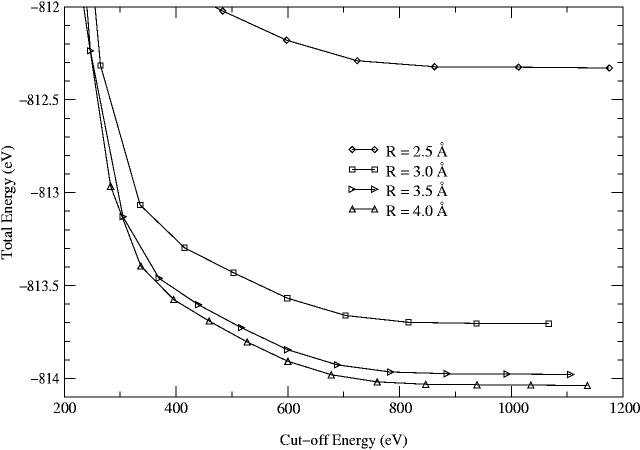
|
In Fig. 1 we plot the total energy of the
chlorine molecule with a bond length of 1.6 Å as a function of
cutoff energy
![]() and basis sphere radius
and basis sphere radius ![]() . The
figure shows that the total energy decreases rapidly as the cutoff
energy and the basis sphere radius are increased, which is to be
expected from the additional variational freedom that is introduced.
Convergence in the total energy is achieved for cutoff energies above
800 eV.
. The
figure shows that the total energy decreases rapidly as the cutoff
energy and the basis sphere radius are increased, which is to be
expected from the additional variational freedom that is introduced.
Convergence in the total energy is achieved for cutoff energies above
800 eV.
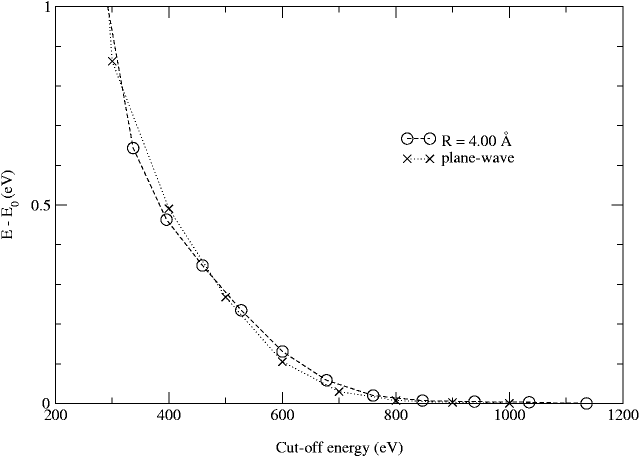
|
Fig. 2 shows that the rate of convergence of the total energy with respect to the cutoff energy is the same for both the localized spherical-wave and extended plane-wave basis sets. This confirms that the energy cutoff concept can be equally applied in the spherical-wave basis set.
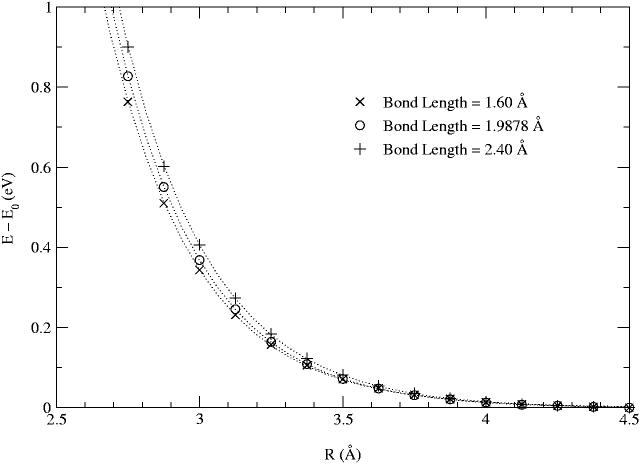
|
Using an energy cutoff above 900 eV, we calculate the total
energy of the chlorine molecule for a variety of bond lengths as a
function of the basis sphere radius ![]() . Fig. 3
shows that the total energy converges exponentially with respect to
. Fig. 3
shows that the total energy converges exponentially with respect to
![]() . We also note that the total energy converges slightly faster
with respect to
. We also note that the total energy converges slightly faster
with respect to ![]() for molecules with smaller bond lengths. This
reflects the fact that for a given
for molecules with smaller bond lengths. This
reflects the fact that for a given ![]() , the basis set is more complete
for a smaller molecule than a larger one because the basis spheres are
closer to one another in the smaller molecule.
, the basis set is more complete
for a smaller molecule than a larger one because the basis spheres are
closer to one another in the smaller molecule.
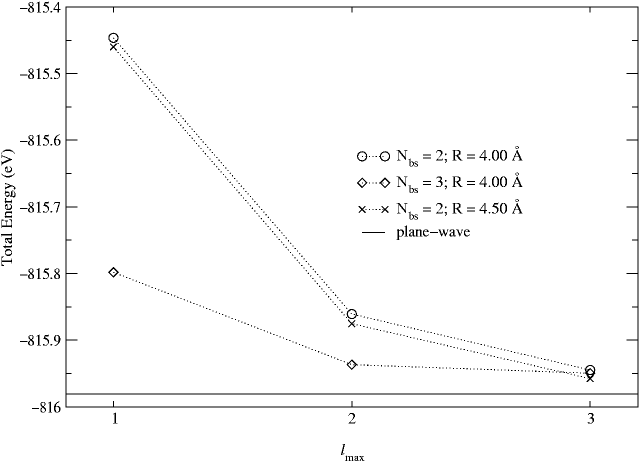
|
Since the total energy also depends on other parameters such as
![]() and the number of basis spheres
and the number of basis spheres ![]() , we
have
performed calculations on the chlorine molecule with a bond length
of
2.4 Å. The results in Fig. 4 show the convergence of the total
energy of the system as a function of
, we
have
performed calculations on the chlorine molecule with a bond length
of
2.4 Å. The results in Fig. 4 show the convergence of the total
energy of the system as a function of
![]() for different
basis-sphere radii
for different
basis-sphere radii ![]() and numbers of basis spheres
and numbers of basis spheres
![]() .
The
rapid convergence of the total energy with respect to
.
The
rapid convergence of the total energy with respect to
![]() is evident from the figure. We note that the ``best'' result
obtained
from the spherical-wave calculation with
is evident from the figure. We note that the ``best'' result
obtained
from the spherical-wave calculation with
![]() ,
,
![]() 4.50 Å, and
4.50 Å, and
![]() gives a total energy of
gives a total energy of
![]() eV, which lies 0.023 eV above the plane-wave total
energy
of
eV, which lies 0.023 eV above the plane-wave total
energy
of ![]() eV. This difference, which is due to the
incompleteness
of the spherical-wave basis set, could be reduced further by
increasing the basis-sphere radius
eV. This difference, which is due to the
incompleteness
of the spherical-wave basis set, could be reduced further by
increasing the basis-sphere radius ![]() and
and
![]() .
However, we are content with this accuracy because the error due to the
incompleteness of the spherical-wave basis set is only about
.
However, we are content with this accuracy because the error due to the
incompleteness of the spherical-wave basis set is only about
![]() of the total energy obtained from the plane-wave
calculation.
The number of spherical-wave basis functions in this case is only
672, which is a small fraction (0.6%) of 112452, the number of plane
waves.
of the total energy obtained from the plane-wave
calculation.
The number of spherical-wave basis functions in this case is only
672, which is a small fraction (0.6%) of 112452, the number of plane
waves.
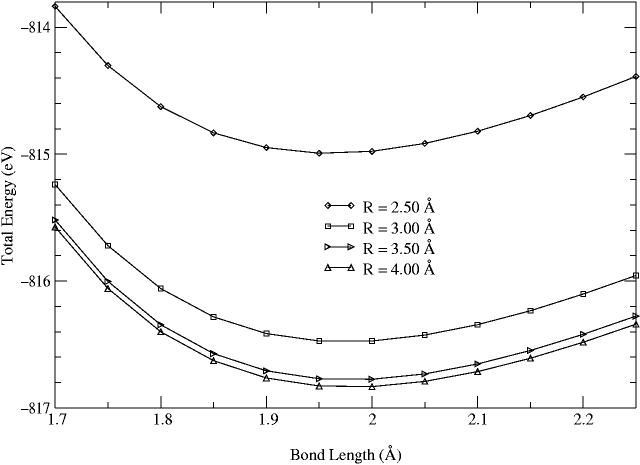
|
To study the effect of
![]() ,
,
![]() and
and ![]() on the calculated
physical properties such as the equilibrium bond length
on the calculated
physical properties such as the equilibrium bond length
![]() and force constant
and force constant ![]() , we perform a series of
calculations on the chlorine molecule for a range of bond lengths from
1.70 Å to 2.25 Å. A typical result is shown in
Fig. 5. The results of the calculations of
, we perform a series of
calculations on the chlorine molecule for a range of bond lengths from
1.70 Å to 2.25 Å. A typical result is shown in
Fig. 5. The results of the calculations of
![]() and
and ![]() with
with
![]() 1, 2, and 3 are displayed in
Tables 1, 2, and
3, respectively. The errors in
1, 2, and 3 are displayed in
Tables 1, 2, and
3, respectively. The errors in
![]() and
and ![]() displayed in the columns headed under
displayed in the columns headed under
![]() and
and ![]() are deduced from the results of the
plane-wave calculations.
are deduced from the results of the
plane-wave calculations.
In Table 1, the values of
![]() and
and ![]() converge rapidly with respect to
converge rapidly with respect to ![]() . However, the results
with two basis spheres and
. However, the results
with two basis spheres and
![]() shows that the converged results
contain unacceptably large systematic errors. The inclusion of a
third sphere reduces the errors significantly because the bonding
region between the atoms is described better by the third sphere. The
results show it is impossible to improve the results simply by
enlarging
shows that the converged results
contain unacceptably large systematic errors. The inclusion of a
third sphere reduces the errors significantly because the bonding
region between the atoms is described better by the third sphere. The
results show it is impossible to improve the results simply by
enlarging ![]() when
when
![]() is used.
is used.
| ||||||||||||||||||||||||||||||||||||||||||||||||||||||||||||||||||||||||
We repeat the calculations for
![]() and
and ![]() with
with
![]() , for which the results are presented in
Table 2. The converged results with
, for which the results are presented in
Table 2. The converged results with
![]() and
and
![]() are better than the converged results with
are better than the converged results with
![]() and
and
![]() , which indicates the importance of
, which indicates the importance of
![]() over
over
![]() for the
``minimal basis set'' calculations. With
for the
``minimal basis set'' calculations. With
![]() and
and
![]() , the error
of the converged results for
, the error
of the converged results for
![]() and
and ![]() are
are ![]() 0.50%
and 13.6% compared to the experimental values, respectively. These
accuracies are acceptable within the LDA.
0.50%
and 13.6% compared to the experimental values, respectively. These
accuracies are acceptable within the LDA.
|
Finally in Table 3, we present the values
of
![]() and
and ![]() using two basis spheres centered on the
atoms
using two basis spheres centered on the
atoms
![]() . As expected, the converged values of
. As expected, the converged values of
![]() and
and ![]() agree very well with the plane-wave results.
We note that calculations with
agree very well with the plane-wave results.
We note that calculations with
![]() are expensive, since the
number of basis functions is almost double that for
are expensive, since the
number of basis functions is almost double that for
![]() .
.
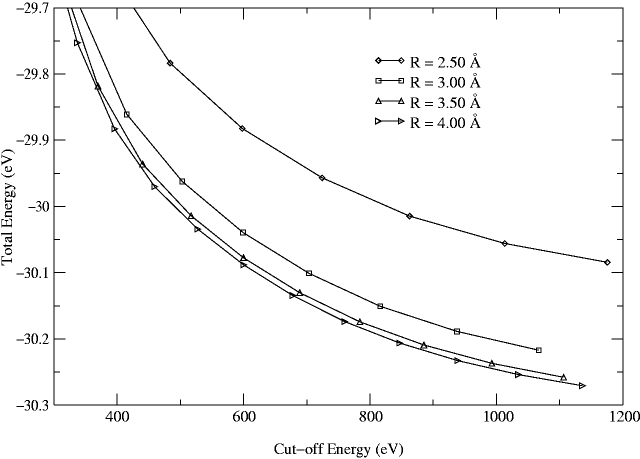
|
Next we calculate the total energy of hydrogen molecule with a
bond length of 1.0 Å as a function of the cutoff energy
![]() , and the basis sphere radius
, and the basis sphere radius ![]() , for which the
results are displayed in Fig. 6. The total energy
converges rather slowly with respect to the cutoff energy because a
bare Coulomb potential due to the hydrogen atom is used. Such behavior
is also observed in the plane-wave calculations. However, the
convergence of energy differences is achieved when the cutoff energy
exceeds 800 eV.
, for which the
results are displayed in Fig. 6. The total energy
converges rather slowly with respect to the cutoff energy because a
bare Coulomb potential due to the hydrogen atom is used. Such behavior
is also observed in the plane-wave calculations. However, the
convergence of energy differences is achieved when the cutoff energy
exceeds 800 eV.
We perform a series of total energy calculations on the hydrogen
molecule for a range of bond lengths to determine the values of
![]() and
and ![]() . The results are tabulated in
Table 4 and show that we can use a value of
. The results are tabulated in
Table 4 and show that we can use a value of ![]() as
small as 3.00 Å to obtain an accuracy of less than 1% in
as
small as 3.00 Å to obtain an accuracy of less than 1% in
![]() and
and ![]() with only two basis spheres. This should be
contrasted with the case of the chlorine molecule where with
with only two basis spheres. This should be
contrasted with the case of the chlorine molecule where with
![]() ,
,
![]() , and
, and ![]() Å, the values of
Å, the values of
![]() and
and ![]() agree only fortuitously with the plane-wave results.
agree only fortuitously with the plane-wave results.
| |||||||||||||||||||||||||||||||||||||||||||||||||||||||||||||||
We can explain why, to obtain the same accuracy, the chlorine
molecule requires a larger ![]() than the hydrogen molecule. The
equilibrium bond length of the hydrogen molecule (which is about
0.74 Å) is smaller than the equilibrium bond length of the chlorine
molecule (which is about 1.99 Å). The bonding region between the
hydrogen atoms is thus described better by the basis functions because
the basis spheres are closer to one another. The hydrogen molecule is
also ``smaller'' (in the sense of the extent of the charge distribution)
than the chlorine molecule.
than the hydrogen molecule. The
equilibrium bond length of the hydrogen molecule (which is about
0.74 Å) is smaller than the equilibrium bond length of the chlorine
molecule (which is about 1.99 Å). The bonding region between the
hydrogen atoms is thus described better by the basis functions because
the basis spheres are closer to one another. The hydrogen molecule is
also ``smaller'' (in the sense of the extent of the charge distribution)
than the chlorine molecule.
In Fig. 7 we show the total energy of the
hydrogen chloride molecule with a bond length of 1.60 Å as a
function of the cutoff energy and the radius of the basis sphere.
The energy differences converge when the cutoff energy exceeds
800 eV. Calculations are performed to obtain
![]() and
and
![]() , and the results are tabulated in Table 5.
, and the results are tabulated in Table 5.
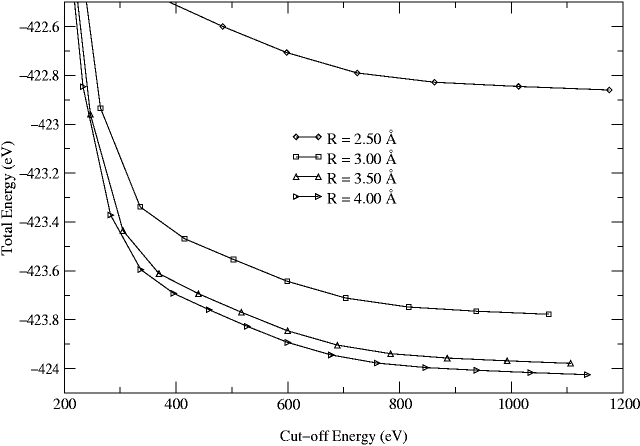
|
| ||||||||||||||||||||||||||||||||||||||||||||||||||||||||||||||||||||||||
We repeat the
![]() and
and ![]() calculations for the
hydrogen chloride molecule, where the radius of the basis sphere
centered on the chlorine atom is fixed at 4.00 Å but the radius of
the basis sphere centered on the hydrogen atom is varied. The results
are presented in Table 6, which
shows that we can use a smaller basis sphere of a radius of 2.0 Å centered on the hydrogen atom to obtain an accuracy of less than 1%.
It is thus possible to use different basis spheres depending on the
atomic species, which is important because this can reduce the
computation time significantly.
calculations for the
hydrogen chloride molecule, where the radius of the basis sphere
centered on the chlorine atom is fixed at 4.00 Å but the radius of
the basis sphere centered on the hydrogen atom is varied. The results
are presented in Table 6, which
shows that we can use a smaller basis sphere of a radius of 2.0 Å centered on the hydrogen atom to obtain an accuracy of less than 1%.
It is thus possible to use different basis spheres depending on the
atomic species, which is important because this can reduce the
computation time significantly.
|
Fig. 8 shows the total energy of the silane
molecule with a Si-H bond length of 1.83 Å, as a function of
![]() and
and ![]() . Total energy differences converge for
cutoff energies above 800 eV. The results of the calculations of
. Total energy differences converge for
cutoff energies above 800 eV. The results of the calculations of
![]() and
and ![]() (for the breathing mode) are summarized in
Table 7. We find that the accuracy is acceptable when
(for the breathing mode) are summarized in
Table 7. We find that the accuracy is acceptable when ![]() 3.00 Å.
3.00 Å.
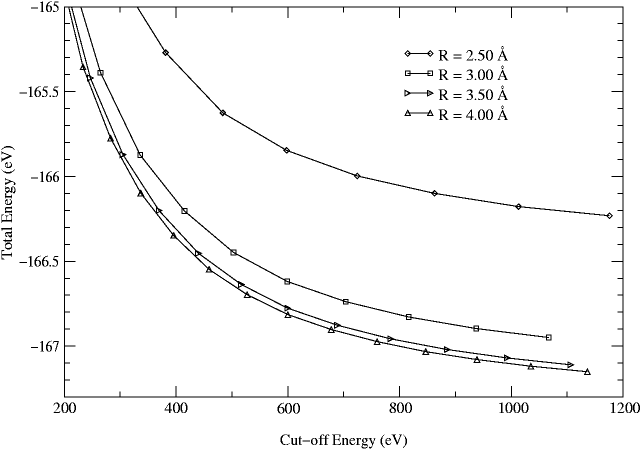
|
|
We repeat the
![]() and
and ![]() calculations on the silane
molecule with the radius of the basis sphere centered on the silicon
atom fixed at 4.00 Å, but with the radius
calculations on the silane
molecule with the radius of the basis sphere centered on the silicon
atom fixed at 4.00 Å, but with the radius ![]() of the basis spheres
centered on the hydrogen atoms varied. The results in
Table 8 show that an accuracy of 1% can be achieved
by using
of the basis spheres
centered on the hydrogen atoms varied. The results in
Table 8 show that an accuracy of 1% can be achieved
by using ![]() Å, which is 1 Å larger than the basis spheres
centered on the hydrogen atom in the hydrogen chloride molecule
calculation (c.f. Table 6).
Å, which is 1 Å larger than the basis spheres
centered on the hydrogen atom in the hydrogen chloride molecule
calculation (c.f. Table 6).
|
From the pseudo-charge density of the hydrogen chloride molecule (Fig. 9), we observe that the valence electrons are concentrated towards the chlorine atom, as expected from the relative electronegativites of hydrogen and chlorine. This enables us to use a smaller basis sphere centered on the hydrogen atom to obtain accurate results. However, from the pseudo-charge density of the silane (Fig. 10), we observe substantial charge density around the hydrogen atoms, reflecting the fact that hydrogen is more electronegative than silicon. Hence for the silane molecule calculations, the radius of the basis spheres centered on the hydrogen atoms need to be larger than that for hydrogen chloride. These observations lead to the conclusion that the relative electronegativities of neighboring atoms in a calculation should be taken into account when choosing basis sphere radii.
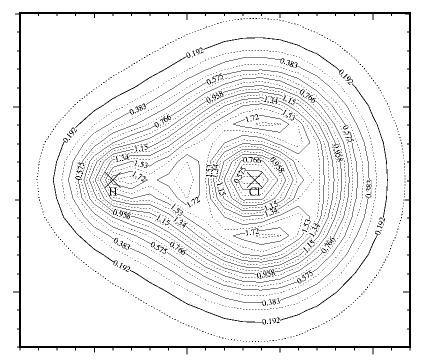
|
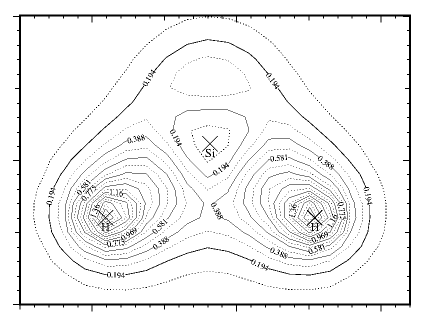
|
We have chosen bulk crystalline silicon to test the performance
of the basis set on an extended system. Fig. 11
shows the total energy per atom for a 64-atom cell of silicon with a
lattice parameter of 5.43 Å as a function of the cutoff energy
and ![]() . The total energy converges at a cutoff energy of about
250 eV. The rapid convergence of the total energy with respect to
. The total energy converges at a cutoff energy of about
250 eV. The rapid convergence of the total energy with respect to ![]() is evident from the figure.
is evident from the figure.
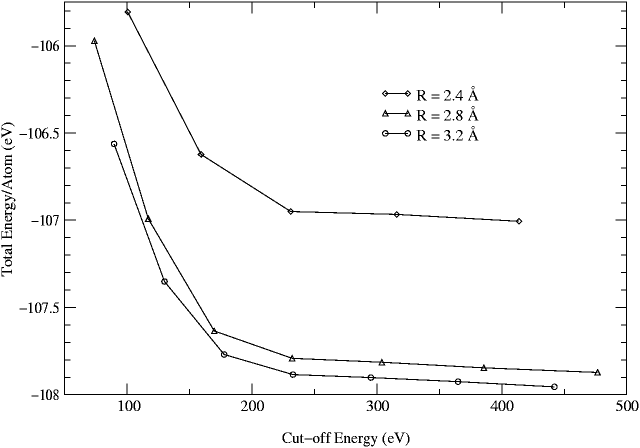
|
To determine the equilibrium lattice parameter, ![]() , and the bulk
modulus,
, and the bulk
modulus, ![]() , we perform a series of calculations on the bulk silicon
system for a range of lattice parameters from 5.31 Å to 5.51 Å.
The results of the calculations with
, we perform a series of calculations on the bulk silicon
system for a range of lattice parameters from 5.31 Å to 5.51 Å.
The results of the calculations with
![]() 1 and 2 are tabulated in
Tables 9 and 10, respectively. It is
found that even with
1 and 2 are tabulated in
Tables 9 and 10, respectively. It is
found that even with
![]() , the results with
, the results with ![]() Å agree quite
well with the plane-wave and experiment results. The calculations
with
Å agree quite
well with the plane-wave and experiment results. The calculations
with
![]() improve the results slightly. The reason why
improve the results slightly. The reason why
![]() calculations give rather good results is because silicon atoms mix the
calculations give rather good results is because silicon atoms mix the
![]() and
and ![]() states to form four
states to form four ![]() orbitals which are obviously
well-described by a basis set with
orbitals which are obviously
well-described by a basis set with
![]() .
.
|
|
Finally we present Table 11 which shows the numbers of basis functions for the spherical-wave and plane-wave basis set calculations. Since in general the number of spherical-wave basis functions is very small for molecules compared to that of plane-wave basis functions, we conclude that spherical-wave basis sets can be used to study molecules and possibly clusters with high efficiency.
|